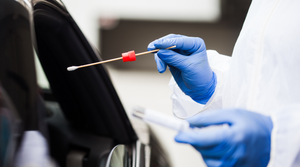Accelerating the Product Development Cycle 2636
September 1, 1997
Medical Device & Diagnostic Industry Magazine
MDDI Article Index
An MD&DI September 1997 Column
PRODUCT DEVELOPMENT
Familiarity with techniques that speed up the design process can help manufacturers increase profit margins by beating the competition to market and extending the product's life cycle.
For managers in the highly regulated and competitive medical environment, accelerating product through the development cycle is critical. A faster cycle gives manufacturers a better chance of getting to market quickly and hitting a home run. A six-month delay can reduce a product's life cycle profits by 33%, according to a well-recognized McKinsey & Co. study.
 This handle for a laparoscopic instrument was made by direct data machining of Ultratem (G.E. Plastics, Pittsfield, MA). Photo by Mark Hundley, courtesy of Bridge Design
This handle for a laparoscopic instrument was made by direct data machining of Ultratem (G.E. Plastics, Pittsfield, MA). Photo by Mark Hundley, courtesy of Bridge Design
It is unlikely that a single initiative, such as raising salaries or creative bonus structures, will accelerate the product development process. Instead, a combination of actions, including changes in management style and in the tools and techniques used in the development process, will be required.
Where does one start, and how can one determine which actions will have the greatest impact? Select an area that can result in the most improvement with the least effort. Be patient and persistent: 20% of the ideas will probably yield 80% of the time savings. Consistently reaping the advantages of this evaluative approach will require diligence. To avoid missteps and resets, managers should check and validate their product development process at each phase. During some intermediate steps, it may be necessary to spend more money to achieve a faster result, but the big overall savings for a project will occur if a polished product--one that is done right the first time--hits the market ahead of its competition.
This article offers tips and strategies for engineering project managers, vice presidents, and CEOs on efficient and practical ways to speed up the product development cycle.
PRODUCT DEFINITION
The first step is perhaps the most important one. Before scheduling a new project, analyze a recently completed job. Compare original schedules with the actual dates achieved to identify the stages in which time was lost and why.
For example, if failure of early production samples caused delays, more product validation tools, such as finite element analysis, may be needed, or an outside specialist could be consulted. Alternatively, a delay may have been caused by the product's marketing definition being changed late in the development process. Make sure simple prototypes--or even breadboards--are given to users as early as possible.
 A handmade foam model like this enclosure can be made in a day (Bridge Design, San Francisco).
A handmade foam model like this enclosure can be made in a day (Bridge Design, San Francisco).
The best stage in which to invest time and money to correct problems is before a project is under way. Waiting until a new project is started puts the team under too much pressure to learn new techniques, qualify new vendors, and purchase new design tools at the same time that they must handle critical path design.
Encourage communication between front room marketing teams and the engineers in the back. Some of the best ideas are developed by interdisciplinary teams rather than by individuals. There is a great potential for improvement when representatives from ergonomics, electronics, manufacturing, management, engineering, service, regulatory, and industrial design all participate at the product development stage. There is some truth to the Dilbert cartoon stereotypes of marketers and engineers. However, opening genuine channels of communication will allow marketing and sales personnel to temper the nerdy engineers, while engineers can resist product ideas from marketing that are complex, inefficient, and impractical. Given the chance to understand the market, engineers grasp nuances that make products more marketable and are further motivated to give their greatest effort.
Engineers should regularly go to trade shows, hospitals, doctors' offices, and academies where they can meet the medical professionals who will use their products. They should also obtain competitors' products so they can dismantle them for analysis.
Adding outside members to the interdisciplinary product development team can make or break the outcome of the product development process. While consultants can be subject to conflicting demands from many clients, they also tend to be exposed to a wider variety of product development techniques, allowing them to keep clients up-to-date and give advice on the most appropriate rapid prototyping (RP) or tooling processes.
Innovative ideas come from experiments, and experiments are not always 100% successful. It's important for product definition teams to know that some avenues will turn into blind alleys. Willingly taking these risks should help the team stay one step ahead of the competition.
Using this risk-and-repair approach can make a product more innovative and get it to preproduction more quickly. While a mistake may cost money in the short term, the holders of a project's purse strings must understand that there is a net savings in the long run. The product development process is something like a freight train consisting of many linked parts, and everyone has to be on board for the duration of the ride.
EARLY PROTOTYPING
Three rules of product development are feedback, feedback, and feedback. This mantra is just as important to product definition. Special prototyping should take place in the product definition stage, not just in the traditional prototyping stage. A brainstorming session that quickly leads to an early-stage hands-on model or visual representation increases the project's chance for success down the road.
Of course, this prototype isn't a full-blown costly model but a mock-up. For example, if portability of a product is a concern, buy an appropriately sized suitcase and put weights in it to test the potential problem before production is under way. Be sure to have real users, as opposed to in-house staff, give feedback on the prototype.
At this point, prototypes should be made with a minimum of effort, dollars, and time. Don't be obsessed with computer-aided design (CAD) systems. Use a glue gun and cardboard, or hack up blocks of inexpensive foam. The physical models will reveal much more than the CAD system. Make sure that someone at each brainstorming meeting is sketching ideas. Industrial designers offer a lot at this early stage because of their strong rapid visualization skills.
Some team members may not have a technical background; they may also be geographically dispersed. To get their input, use a variety of techniques, including CAD tools, sketches, and rapid prototypes--any alternative to traditional blueprints that are often too technical to understand. Try CAD drive-throughs on big color monitors when the whole team is present.
Some interesting Web tools allow use of a browser to examine 3-D CAD files without having the expensive CAD program resident at a remote location. Customers and team members can look at design ideas during a phone conference with the rest of the design team. Videoconferencing, which is relatively inexpensive today, is another option.
 Small tubular components can be made in four to six weeks using the Keltool process (3D Systems, Valencia, CA), sintering steel powder around a stereolithography pattern.
Small tubular components can be made in four to six weeks using the Keltool process (3D Systems, Valencia, CA), sintering steel powder around a stereolithography pattern.
Schedules are often drawn in a linear fashion. However, the shortest time to market is achieved with schedule sections that overlap and with data that easily move back and forth between sections. This kind of scheduling is commonly referred to as concurrent engineering. But not all concurrent schedules are created equal, and many design tools don't allow a bidirectional flow of information between industrial design, electrical engineering, and mechanical engineering.
Test run and think through your CAD data flow as early as possible in the product definition stage. Select CAD tools that allow a two-way process. For example, industrial design CAD packages look flashy, but it may be easier building the industrial design in the mechanical design CAD package. Solutions might also involve developing relationships with new vendors who have more suitable CAD, holding internal training sessions with existing vendors, or even investing in better translation software.
RAPID PROTOTYPING AND BREADBOARDING
The key words in rapid prototyping and breadboarding are early, often, and appropriately. These guidelines can provide major time savings. In fact, the savings potential is so great that it can pay to buy RP machinery to gain a competitive advantage.
Making accurate physical models of the design used to be the slow stage of the product development process. However, the new RP techniques have reduced both cost and time by about a third during the past five years. Three times as many prototypes can be made for each product in the old time frame, taking designs to a more sophisticated and complete level before committing to tooling.
Much has been written on the slice-and-dice RP techniques in which a special software package slices the CAD model into thin sections that are reconstructed on a platen. A laser or similar photonics-based system solidifies a photopolymerized resin or sinters a plastic powder to create the parts microlayer by microlayer.
In the product definition stage, use obvious tools such as cardboard and foam or laser cutting to build simple kits. Laser cutting is also useful to create easy-to-evaluate cross sections of the dynamic mechanisms. Use laser cutting of circuit board material to create overnight mechanical samples of printed circuit boards (PCBs) to check connector and key component placements rather than wait for turns of the real PCB, which can take several weeks. High-strength polymers such as acetal can be laser cut to evaluate dynamic strength issues early.
About the Author(s)
You May Also Like


